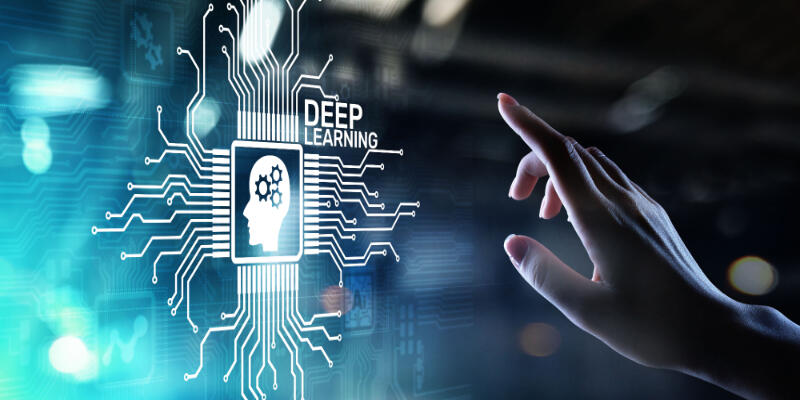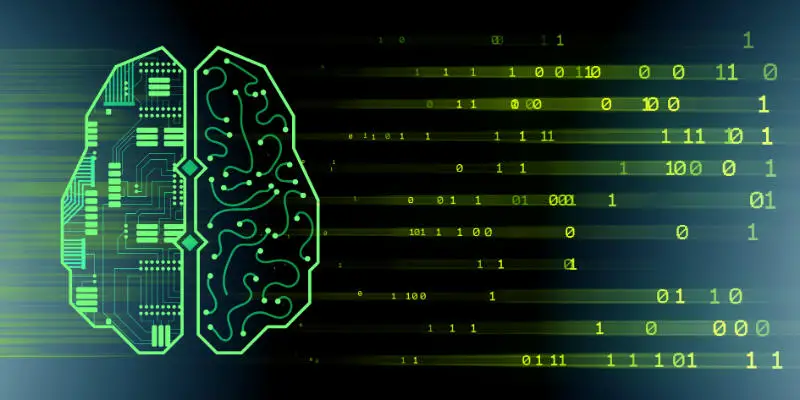Disclaimer: This post may contain affiliate links, meaning we get a small commission if you make a purchase through our links, at no cost to you. For more information, please visit our Disclaimer Page.
Deep learning is one of the most exciting fields in modern artificial intelligence research, with applications in a variety of areas ranging from self-driving cars to advertising to natural language processing. Thanks to deep learning, today’s machine learning algorithms can solve problems that were deemed impossible just a few years ago.
Data scientists need to understand deep learning techniques and use them, especially when dealing with massive data. Deep learning’s supremacy lies in its incredible power to accurately train with big data, and therefore it’s an essential skill for data scientists.
Table of Contents
What Is Deep Learning?
Deep learning is an advancement of traditional machine learning, where artificial intelligence technology is used to handle big data.
Artificial neural networks run algorithms that help machines learn to perform tasks that would typically require human intelligence to operate.
The human brain is trained through the repetition of procedures and tasks. Deep learning works in a similar manner, where a deep learning algorithm is set to perform a similar task repeatedly as it learns the problem and improves the result.
The deep learning curve is hierarchical, as it is built in layers to learn and represent data at different levels. It goes from less abstract to more abstract. It follows a ‘thinking’ process pattern, similar to that of a human brain, as it learns to solve the problem at hand.
An example of deep learning is the online translating tools that can almost accurately translate one language to another. The deep learning algorithm keeps learning and every time gives a better result to translation queries.
With the raging advancements in AI, deep learning is overwhelmingly taking over machine learning in every sector, and its popularity is undeniable.
Deep Learning Vs. Machine Learning
Machine learning takes a traditional approach where algorithms are run to parse data, learn it, and then use and manipulate it according to what they learn. But, deep learning holds a more considerable promise than that because of its learning flexibility.
As a subset of machine learning, deep learning learns data with great flexibility and represents it in a hierarchy of concepts, such that more abstract concepts build on the less abstract ones.
For example, in face recognition, the first layer algorithm recognizes the pixels, shape and maps outs the edges of the image.
The second layer algorithm learns the distinct shapes of the eyes, nose, and mouth and identifies them. The third layer algorithm learns to distinguish each of the features that define the human face.
In machine learning, a domain expert is required to identify features that reduce data complexity and identify patterns for the algorithms to learn smoothly.
Deep learning eliminates the need for a domain expert, as it has high-level features to learn from data incrementally.
Machine learning and deep learning problem-solving techniques differ too. Machine learning approaches the problem by breaking it down into problem statements that need solving.
These problem statements are dealt with differently and then combine the results at the end. With deep learning, problem-solving is end-to-end, with an instant output of the results.
Machine learning is excellent for small data; that’s why many sectors continue using machine learning techniques for their data analysis despite the hype around deep learning.
For organizations like Google who collect massive data, deep learning techniques are necessary to accurately handle large data.
What Is Deep Learning In Data Science Used For?
Data science has largely embraced deep learning, thanks to big data that exceeds conventional data analysis techniques.
The challenge to manage high volumes of data calls for deep learning algorithms to make sense of it.
In data analytics, professionals face challenges like imbalanced input data, structure variation in the raw data, inconsistent analysis, and others.
Data scientists use deep learning algorithms in these ways to help them navigate through these challenges.
Semantic Indexing
When dealing with big data, retrieving helpful information from it can be challenging. Semantic Indexing helps to analyze the data by identifying patterns and establishing relationships between concepts and words in the unstructured data.
With deep learning, unsupervised data is leveraged so that there is a higher data input for better representations.
Data scientists use this deep learning algorithm technique to improve data representations and retrieve documents effectively. Semantic Indexing has proven useful in improving search engine results.
Perform discriminative tasks
Discriminative tasks work separately on sections of data, focusing on implementing specified algorithms on it and isolate the rest.
Deep learning allows a data scientist to extract nonlinear features from raw data and conduct discriminative tasks.
This action adds nonlinearity to the process of data analysis, increasing its computing efficiency. It makes work easy to accomplish complicated tasks with artificial intelligence, like image recognition.
Semantic video and image tagging
When dealing with a complex image or video data, deep learning techniques are useful in facilitating segmentation and annotations.
The independent variant analysis feature in deep learning helps it learn invariant features from the video data, thus extracting them for isolated tasks.
An example is the Microsoft Research Audio Video Indexing System. It uses deep learning techniques coupled with artificial neural networks to facilitate audio and video searches through speech recognition. It can extract words from the videos and audios, generating captions that are matched against speech content to access the audio and video files.
Data tagging
In data tagging, discriminative tasks are performed on the abstract data representations. Deep learning applies uncomplicated linear modeling methods on the extracted complicated features to tag massive data amounts.
In big data analysis, deep learning has made significant accomplishments in extracting helpful features like representations that ease the performance of discriminative tasks on sets of data.
These results allow for data tagging, information retrieval, and improving search engine results.
Having made these major strides, deep learning still has room for further exploration to increase its applicability in data science, especially in big data analysis. Some of these areas include:
- Improve learning with non-stationary data – Data is diversifying, and so there is more streaming data input in many sectors like fraud detection. Deep learning algorithms that can handle fast-moving continuous data should be developed for such functions.
- Increase scalability for high-dimensional data – The layer hierarchy of deep learning makes it computationally expensive to handle high-dimensional data like images. Scaling up deep learning models will increase its learning time and implementation simplicity.
- Introducing innovative large-scale models for deep learning – The already set-up models are well-suited to handle massive data volumes. Still, innovations can be made to improve learning for complex data patterns.
Where To Learn Deep Learning For Data Science?
Deep learning is a complex subject that requires in-depth knowledge and strong machine learning skills. As a data scientist looking to master deep learning, you can find some of the best courses online to position you on the right path.
The world is taking a direction in Artificial intelligence as automation takes over in most sectors. Therefore, Deep learning, machine learning, and data science are crucial in developing technology systems.
There are hundreds of courses on different online platforms where you can learn. However, I have compiled a short list highlighting some of the best courses you can use to launch your deep learning journey.
They include:
Andrew Ng’s Deep Learning Specialization on Coursera
Coursera is a resourceful online learning platform for deep learning. A master in machine learning and deep learning, Andrew Ng, prepared a classic course to introduce beginners to machine learning, especially those with a non-technical background. He has other courses like ‘AI for Everyone,’ which helps beginners familiarize themselves with AI concepts.
In his Deep Learning Specialization course, modules follow a bottom-up teaching approach, where you start with the basics and build on them.
By the end of the course, you’ll learn the fundamentals of deep learning and neural networks and how to use deep learning to handle projects successfully.
The course is student-interactive to ensure that you learn hands on, with constant practice on the knowledge you acquire. Your practice case studies will range across different sectors, and you can practice them in Python.
Introduction to Deep Learning – Coursera
This impressive course on Coursera Introduction to Deep Learning aims at equipping learning with basic modern artificial neural networks and their use in different areas. Learners also familiarize themselves with the application of AI in computer vision and understanding natural language.
The course builds on your previous knowledge of linear modeling and stochastic optimization models. The course is designed to explain their building blocks and how each layer works to understand neural networks.
The course primarily uses Python, so proficiency in the language will ease your learning process. If you’re yet to master Python, taking a polishing course on it would be a great start.
Jeremy Howard’s Practical Deep Learning for Coders (Fast.ai)
Practical Deep Learning for Coders on Fast.ai is a classic deep learning course that follows a top-down learning approach (unlike Andrew Ng’s bottom-up approach).
The course first introduces you to the product, and then you break it down into individual parts.
The step-by-step structure allows learners to understand the deep learning concepts and the neural networks technology easily. Since you start with the product, it’s easy to systematically follow through and build on the concepts.
Deep Learning A-Z™:Hands-On Artificial Neural Networks – Udemy
Udemy offers a detailed course Deep Learning A-Z™:Hands-On Artificial Neural Networks to equip learners with everything a deep learning expert should know.
It doesn’t stop at the basics level, as it covers advanced concepts like ANN and CNN.
You can tell it’s an excellent course considering the over 20,000 reviews and a quality rating of 4.5. It comes packaged with practical exercises, tutorials, and real-life cases to solve.
By the end of the course, you should be equipped with hands-on experience on deep learning concepts relevant to Data Science.
Data Science: Deep Learning in Python – Udemy
Data Science: Deep Learning in Python is another excellent deep learning course on Udemy. It goes deep into neural network theory, focusing on step-by-step learning for most concepts.
By the end of the course, you will have created a neural network from scratch, as there is a detailed guide on how to do it.
As a data scientist, you’ll benefit from in-depth mathematics explanations on advanced concepts like ANN. If your goal is to master deep learning in detail, this course will do that for you.
Conclusion
Progressive technology advancements will see deep learning continue to grow, and machines are getting more intelligent.
It’s no wonder Netflix knows which movie you’d like to watch next, and so they suggest it to you. In data science, the process of data analysis will experience more accuracy and efficiency, even when handling big data.


